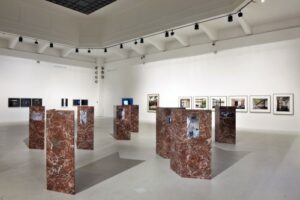
Before photography was discovered, buildings were mediated through painting – famous museums, unable to collect monuments, had collected paintings of them. One of the oldest museums in Europe, The Teylers Museum in Netherlands, whose display has been unchanged for the last 200 years, has paintings of churches exhibited next to fossils, rocks, ancient prints and bizarre instruments. Nowadays it is photography that brings architecture to viewers. But photography also takes from architecture – like the frescoes in Pompeii and baroque trompe l’oeil – photography carries on the idea of decorating interiors with representations of other interiors. Though the relationship between the two can be much deeper than that: two shows in Vienna – the architects’ Mecca – prove there is a huge potential in the topic.
In the city’s renowned Museum of Applied Arts (MAK) since last year’s December an exhibition titled „Envisioning Buildings” is to be seen, to a constant interest of visitors. One of the reasons for this interest could be attributed to the presence of many famous names in the show – Andreas Gursky, Candida Höfer, Sarah Morris, Cyprien Gaillard, Thomas Ruff, Allan Sekula and Tobias Zielony, just to mention the top of the list. Through the eyes of these contemporary masters we look at iconic buildings of the 20th and 21st century, including the work of modernists Frank Lloyd Wright, Erich Mendelsohn, Berthold Lubetkin and Mies van der Rohe, as well as of recent architect stars, such as Frank O. Gehry, Herzog & de Meuron, and Kenzo Tange. A special place is reserved for Rudolph M. Schindler whose house in Los Angeles has become location of a MAK’s own museum branch – the MAK LA Center for Art and Architecture.
The exhibition is structured into eight thematic chapters —Restoration, Reanimation, Dwelling, Utopian Visions, Refraction, Deconstruction, Critique, and Systems Analysis. It reveals an extreme variety of approaches to „envisioning buildings”, showing that the relationship between photography and architecture can become quite complex. After all photography, though produced by a “machine”, is not just a Xerox copy of the world it represents. There is the photographer’s vision in between. This vision can be that of a documentarist, sensitive to social injustice – like Allan Sekula, who in the work “Gala” criticizes the social discrimination during opening of Frank O. Gehry’s Walt Disney Concert Hall; it can be that of a cultural investigator reconstructing a lost communist monument – like Marko Lulic in “Karl, Rosa, and Mies”; or that of a perception tester, who explores the relations of scale between the reality, the picture and the eye (Geoff Kleem). But regardless of divisions, all of the works (almost forty in total), if videos or prints or installations, aim at making a meaning of the place they portray – at interpreting it and giving it content, in their own, free, artistic way.
Whereas architecture has to – in principal – produce inhabitable forms, art produces representations of the world, in which people were never meant to live. Humans are almost invariably absent in the photographs shown here, as if their presence would only destruct the composition. We see men cleaning the windows of a Glass House in Sara Morris’s “Points on a Line”, we see remains of women’s clothing in John Massey’s “Phantoms of the Modern”, but other than that the world portrayed here seems uninhabited. Only children playing on what is left over from Pasmore’s Apollo Pavilion, in Jane and Louise Wilson‘ s video “A Free and Anonymous Monument”, bring some life into the concrete forms, though ironically, in this work, it is the architecture that is dead.
Another exhibition, that until recently was running parallel in Christine Koenig Gallery, presented an architectonic maze of cut outs and close ups of various structural details, arranged closely on the gallery walls. The works, by Margherita Spiluttini, presented in such manner, remind of baroque decorations – their precise, geometrically ordered content, is like that of an ancient fresco, which through variations in scale and order of elements, plays with the viewer’s perception. One of Spiluttini’s favourite motifs are transitional places – stairwells, bridges, passageways: wanting to follow these, the viewer’s eye will soon find itself deceived – through they lead to nowhere. Here the road through perception is the goal in itself.
These places reflect life in its condensed fleetingness and contingency – we read in the exhibition text. Though we see no life in them. Architecture is only a mould taken of our itineraries. It is like a mirror, which reflects – on its cold glass surface – our social habits and movements, but does not allow their trace to stay. And although the artist stresses the social aspect of the photographed spaces – the spaces where people briefly come together, where a special, informal mode of communication evolves – here again we meet no humans.
photocredits:
1- 3 MAK Exhibition Views © Wolfgang Woessner/MAK
4. John Massey, „Action in chains“ © John Massey; courtesy David Daniels + Kate Alexander Daniels, Toronto, Canada
5. Margherita Spiluttini – Exhibition View © Gallery Christine Koenig, Vienna
____________________
ENVISIONING BUILDINGS – Museum of Applied Arts – MAK, Vienna
https://www.mak.at
Participating artists
Sabine Bitter & Helmut Weber (AT), Mladen Bizumi? (NZ/AT), José Davila (MX), Werner Feiersinger (AT), Andreas Fogarasi (AT/HU), Cyprien Gaillard (FR), Andreas Gursky (DE), Gavin Hipkins (NZ), Candida Höfer (DE), Geoff Kleem (AU), Joachim Koester (DK), Luisa Lambri (IT/ US), Thomas Locher (DE), Marko Luli? (AT), Dorit Margreiter (AT), John Massey (CA), Maix Mayer (DE), Sarah Morris (UK/US), Warren Neidich (US/DE), Sandra Peters (DE), Pia Rönicke (DK), Thomas Ruff (DE), Allan Sekula (US), Thomas Struth (DE), Hiroshi Sugimoto (JP/US), James Welling (US), Jane & Louise Wilson (UK), and Tobias Zielony (DE)
MARGHERITA SPILUTTINI Gallery Christine Koenig, Vienna
https://www.christinekoeniggalerie.com/





Leave a Reply